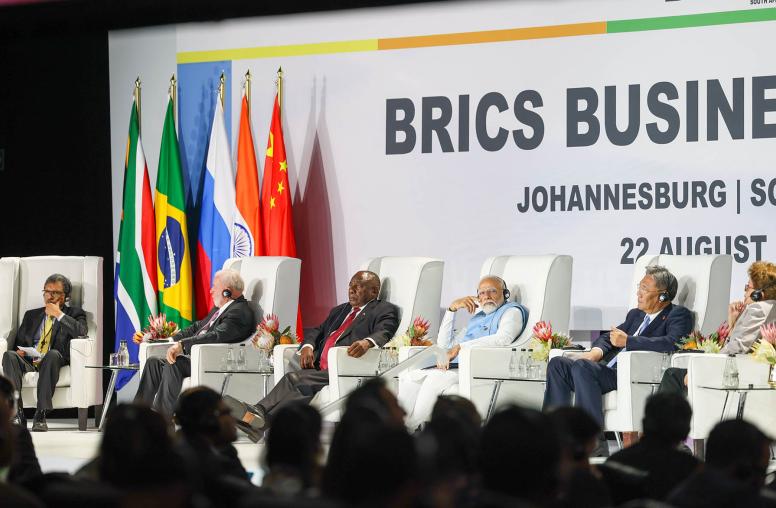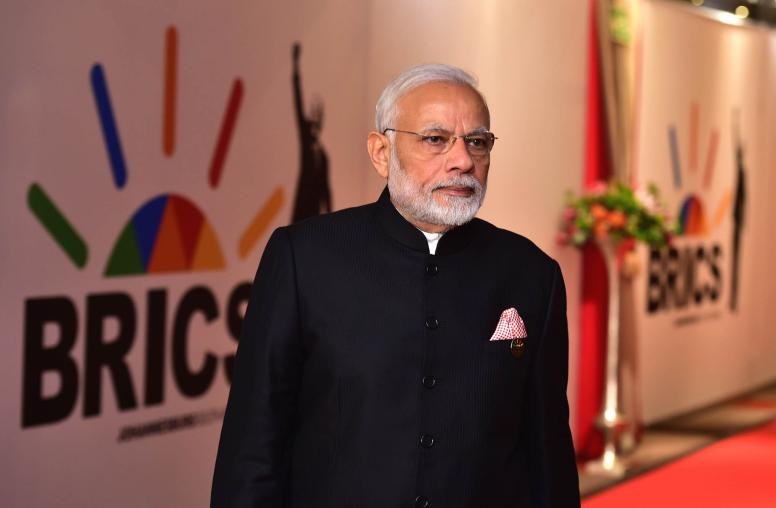What’s the Deal with INDUS-X?
While initially met with little fanfare, this U.S.-India defense technology initiative could prove crucial for deterring China.
There was no shortage of splashy headlines during Indian Prime Minister’s trip to Washington last June. However, the launch of the U.S.-India Defense Accelerator Ecosystem (INDUS-X), a joint technical initiative focused on building an “innovation bridge” between the two countries, went relatively unnoticed.

Despite this lack of initial fanfare, INDUS-X is already delivering results less than eight months later — breaking information silos, building networks and reducing regulatory friction between the U.S. Department of Defense and the Indian Ministry of Defense.
And with its second summit planned for February 20-21, INDUS-X has the potential to be one of the most consequential partnerships for U.S.-India cooperation going forward. That might seem like a bold prediction, especially given the more than 20 years of steadily growing defense and intelligence relations between the United States and India. But INDUS-X has finally institutionalized a process that meets India’s decades-long demand for defense technology cooperation while advancing the Pentagon’s concept of integrated deterrence by bolstering Indian defense capabilities, diversifying supply chains and building trust for deeper operational cooperation between our two militaries.
As the INDUS-X initiative continues to develop, understanding its function, background and strategy will be crucial for policymakers looking to shape not only the trajectory of U.S.-India relations, but the future of integrated deterrence — particularly with regards to China — in the Indo-Pacific and beyond.
A Renewed Urgency for U.S.-India Defense Cooperation
Since India’s independence, it has pursued technopolitical goals and prioritized science and technology progress as a marker of economic development, military power and international prestige — most notably through its nuclear program.
As U.S.-India relations warmed in the 2000s, technology was a top priority for both countries, which facilitated a number of joint agreements. The U.S.-India civil nuclear agreement launched in 2005 and approved by Congress in 2008 enabled India to become the only non-signatory of the global nuclear nonproliferation treaty exempt from several technology denial regimes. In this signal moment, the United States helped usher India into the cartel of countries that legally trade nuclear materials and opened the door to cooperation on defense and dual-use technologies. The first U.S. defense sales to India began that year and have now reached well over $20 billion.
The 2012 Defense Technology and Trade Initiative (DTTI) offered an ambitious approach to greater defense technology co-development and coproduction. Despite procedural advances in the defense relationship, the DTTI seemed to fizzle out due to a general lack of urgency and insufficient top-down pressure to overcome the mismatches in expectations and bureaucratic procedures.
China’s recent aggression against U.S. allies and interests — including along India’s borders and in its maritime zones — re-sparked bilateral urgency for more and better defense technology cooperation.
The burdensharing required for integrated deterrence of China is monumental. It spans not just the coordination of military forces with partners and allies, but also collective industrial production and the development of future capabilities.
U.S. and Indian leaders recognize that pooling their science and technology ecosystems and collective “innovation power” will be bring strategic advantages.
India will be able to access and develop better sensor to shooter technology to stress Chinese military planning assumptions and defend its borders from Chinese aggression.
Technology sharing will facilitate a culture of trust that could bolster U.S. efforts for greater military operational coordination in the Indo-Pacific in peacetime and in crisis — from mutual logistics and maintenance to access and overflight to resilient space-based communications.
India’s industrial base can also provide redundancy and resilience to the increasingly stretched industrial base in the United States and Europe, such as javelin anti-tank missile production lines. Indian defense industry will also be able to compete with China and Russia for markets and influence in the Global South.
And in the competition for “software supremacy” that will determine future military decision-speed advantage, India’s hosting 20 percent of the world’s chip designers and ranking in the top third of the global innovation index make it a valuable partner.
The Formation of INDUS-X
With the need for closer defense and technology cooperation clear, the question quickly became a matter of what cooperation would look like in practice. It not only requires deeper commercial ties across U.S. and Indian defense industries, but also greater horizontal cooperation between governments, academia and labs, as well vertical partnerships between established defense primes and startups or small and medium enterprises (SMEs).
The U.S. Department of Defense fact sheet on INDUS-X released last June directly references the need to “expand the strategic technology partnership and defense industrial cooperation.” INDUS-X seeks to build these links through three core mechanisms: enhanced information flows; cross-national social and commercial network development; and reduced regulatory friction to unleash private enterprise.
Information: Addressing information asymmetries is essential for fostering commercial collaboration. Policymakers, regulators, firms, engineers and entrepreneurs may not be well-versed in each other’s defense companies, products, research and development capacity, or acquisitions processes. Establishing a clearinghouse through INDUS-X can solve the information gaps on decision-making nodes, processes, timelines and opportunities.
Such efforts can also demystify U.S. export control reviews or the continuously evolving Indian defense acquisition procedures. Some information efforts can focus on illuminating existing opportunities for international collaboration such as cooperative research and development agreements, the foreign comparative testing program, or the range of collaborative science opportunities provided by labs outreach arms like ONR-Global.
Networks: INDUS-X is also focused on stimulating cross-national science and technology networks and building the connective tissue between domestic entrepreneurs, markets, skilling institutions, government labs and investment capital, which is critical to building successful innovation ecosystems. As one scholars explains: “Social networks provide vital information that neither markets nor government easily capture … In so doing, networks drastically reduce the high costs and risks of innovation.” Building these networks beyond high-level convenings requires sustained, routinized instruments such as research collaborations, joint challenges, industrial partnerships and joint investment funds, such as the U.S.-Israel Bi-National Industrial Research and Development Foundation, which de-risked cross-national joint ventures while actively matchmaking companies to accelerate Israel’s IT industry.
One promising variant of industrial partnerships is the mentor-protégé partnerships (MPPs) — a program developed by the Pentagon in 1990 — to pair defense “primes” with SMEs to develop the technical and business capabilities to compete as subcontractors in global supply chains. While the Pentagon uses this tool to help upskill U.S. small businesses, Lockheed Martin has recently signed international MPPs with Australian companies working on technologies for defense satellite communications systems to passive surveillance.
Regulatory: A third focal point of INDUS-X is reducing the regulatory friction around integrating and networking defense knowledge, goods and services. Both governments have engaged with industry to better evaluate the costs and benefits of the regulatory environment on both sides — including export, disclosure and procurement rules that might hamper collaborative innovation and the diversification of supply chains. In many cases, regulation is not an insurmountable obstacle, but produces friction through longer review timelines, visa delays and market uncertainty, which can stymie the speed and scope of innovation. Remedies like national carve outs or expedited reviews can mitigate some friction.
Progress to Date
The INDUS-X framework has already witnessed considerable progress toward these objectives. Information exchange between the government and private sector has accelerated on-ramps into both countries’ defense industrial supply chains. The two innovation leads — the U.S. Defense Innovation Unit (DIU) and India’s Innovations for Defence Excellence (iDEX) — are now in regular dialogue and recently launched the INDUS-X Gurukul Education Series to convene government and private sector players.
INDUS-X has also started networks between industry, startups, venture capital, academia and policymakers. A series of industry summits and idea conclaves have sprung up alongside government-to-government meetings and intersessionals of INDUS-X, which weave together a network of players from the private and public sectors. USIP is one among several organizations referenced by the Pentagon that has helped convene dialogues between private and public stakeholders to clarify roadblocks to technology cooperation and identify pragmatic solutions.
Collaborations have been forged in academia — like between IIT-Delhi and Penn State (home to a major University Applied Research Center) — and between accelerators like H4X and FedTech with new Hyderabad-based incubators.DIU and IDEX launched two joint challenges on maritime ISR high-bandwidth underwater communications, with prizes expected to be awarded to startups along with potential procurement opportunities.
MPPs have yet to take off, but an informal approximation of this type of partnership has been visible within the recent MQ-9B deal. General Atomics established technical partnerships with two Indian startup companies — 3rdiTech and 114ai — to develop customized ISR chips as well as AI tools for multi-domain awareness, which will integrate into the MQ-9B drones India seems very likely to acquire.
From a U.S. strategy standpoint, there is a throughline between this de facto MPP, India’s acquisition of American platforms for enhanced ISR capacity, and the contribution of greater “deterrence by detection” in the Indo-Pacific.
Regulatory friction has been the hardest challenge so far, just as it has been for AUKUS. Recent industry summits have featured roundtables with U.S. export controls offices to help guide Indian SMEs on how best to navigate these processes. Anecdotally, Indian companies that have recently gone through reviews of technical assistance agreements or export administration regulations have reported relatively quick decisions, which may encourage more U.S. companies to explore technical partnerships.
What’s Next for INDUS-X
As the appetite for technology cooperation expands alongside shared core national security interests, INDUS-X offers a historic opportunity for the United States and India to scale the depth and breadth of cooperation.
INDUS-X could increase the number of contact points between startups and primes through scouting trips and delegations by U.S. and Indian primes to get acquainted with new U.S. and Indian startups and enable their visibility at defense exhibitions.
On the networking front, scaling joint challenges is essential, but the next steps for co-innovation will require joint prototyping and product development, as well as talent flows. A joint investment fund could be seeded by government funds to de-risk and crowd-in private investments in defense startups. MPP’s could be financed by defense ministry budgets, or through creative partnership-incentive mechanisms such as Indian Ministry of Defense crediting offset discharges or U.S. Department of Defense offerings for higher technical ratings.
From a regulatory standpoint, international arms trafficking and export controls remain essential to guard U.S. technology advantages, but the navigation between protecting and sharing with other tech coalitions like AUKUS and NATO’s DIANA program can inform INDUS-X. Application of novel approaches like anticipatory technology release policies or pre-approval of certain project domains and trusted entities could help companies identify the safe sandboxes and partners to expedite commercially viable innovation partnerships.
While INDUS-X trends upwards, it could be further strengthened if both partners take advantage of opportunities for greater operational coordination that will reveal mutual needs and deliver global security goods, for instance in the protection of maritime shipping under threat in the Indian Ocean. The U.S. vision of partnership and balancing is not merely economic and technological exchange but “actually operating together … in the field.” The pace and depth of teaming U.S.-India operational cooperation and technology will then be mutually reinforcing.
Nevertheless, INDUS-X has initiated the information, network and regulatory mechanisms to deepen cross-national defense technology collaboration, which is poised to strengthen the bonds of U.S.-India partnership, innovation and deterrence.



